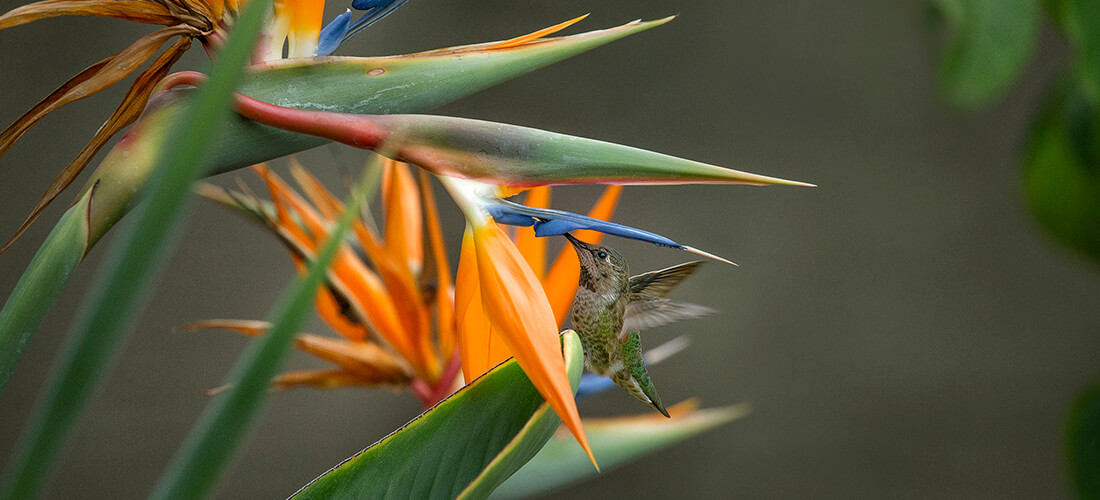Exotic and eye catching, bird of paradise Strelitzia plants are among the world’s best-known plants. Named for the exquisitely plumed birds of paradise of Papua New Guinea, the flora certainly does the fauna proud, having become a blooming success in the eyes of humans.
BY Wendy Perkins
Photography by Tammy Spratt
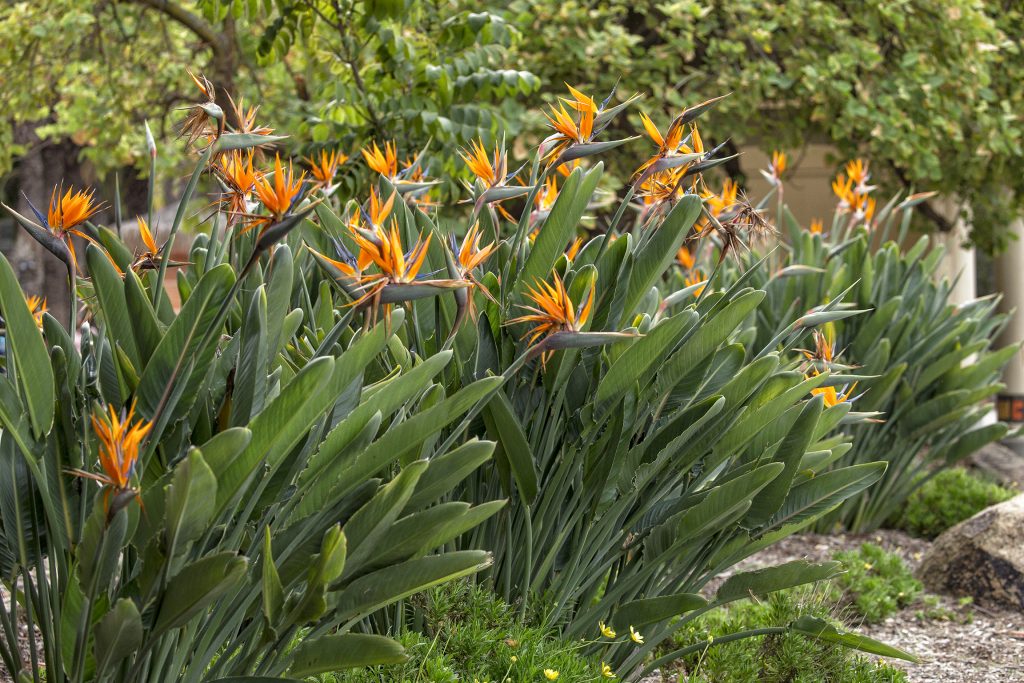
Humble Beginnings
In some ways, the story of bird-of-paradise plants is a variation on the “small town kid makes good” tale. These plants, native to a relatively small area of subtropical coastal areas of southern Africa, are now cultivated worldwide. They are stalwart landscaping staples throughout Southern California as well as other subtropical regions. The most famous part of the plant, the large, bold blooms, make a statement in sophisticated floral arrangements—and are both the blossom of ninth wedding anniversaries as well as the official flower of the city of Los Angeles.
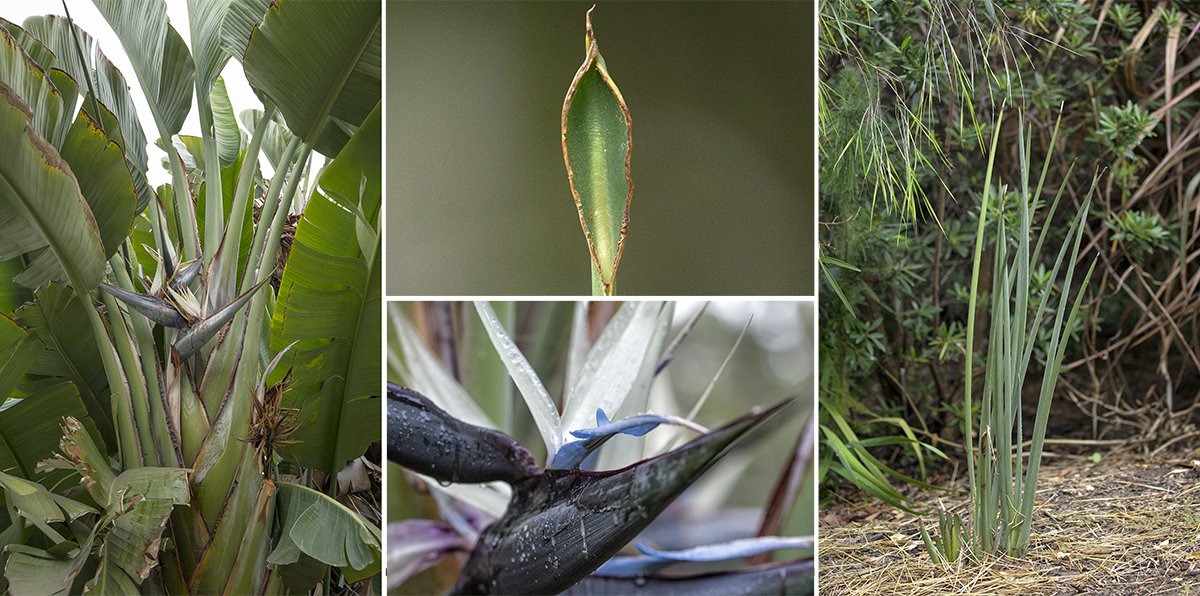
VARIETY ABOUNDS
Clockwise from left: The lush banana-plant-like leaves of the giant bird-of-paradise can reach 6 to 8 feet in length—the plant itself can grow to 30 feet in height; Although the narrow-leaved variety S. juncea are considered leafless, a thumbnail-size leaf adorns the tip of many of the stalks; The name-earning growth of S. juncea aren’t narrow leaves, but the plant’s petioles, or leaf stems; Blooms of the giant bird-of-paradise S. nicolai have the same structure, but paler colors than the iconic S. reginae;
The five species of bird-of-paradise plants range in size from the fairly short, shrubby bird-of-paradise Strelitzia reginae to the towering tree-like giant bird-of-paradise S. nicolai. Most have paddle-shaped leaves that resemble those of a banana plant. One outlier of the genus, however, narrow-leaved bird-of-paradise S. juncea has thin, spikey, rush-like leaves. In fact, the specific name juncea is a nod to the family of rushes, Juncaceae. As evergreen plants, bird-of-paradise leaves are found in abundance year-round. These plants have a long blooming period, too—sometimes year-round—which is good news for nectar-seeking animals.
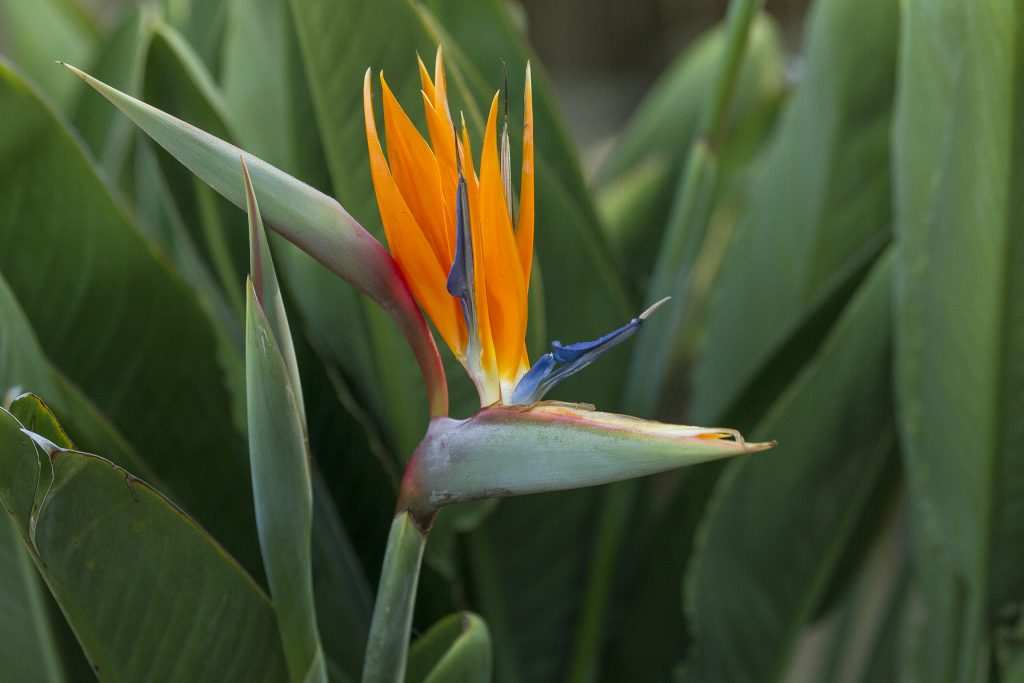
Form Follows Function
Look at enough flowers, and a trend can be seen; the structure of a bloom often corresponds to the morphology of certain pollinators, be they bird, insect, or mammal. Color and scent (even if not apparent to the human nose) draw the attention of the pollinator. They usually come for the nutrient-dense nectar, and in gathering it, incidentally pick up and distribute pollen (some pollinators also eat a portion of the pollen). Some flower structures serve as nectar guards, ideally keeping the pollinator working hard to reach the nectar. The more time spent on the flower, the more pollen exchanged. Bird-of-paradise flowers have just such an arrangement.
Set atop long stalks, Strelitzia flowers have a complex structure. A green, red, or purplish canoe-shaped bract (a modified leaf) opens along the top. Flower petals, stamen, and stigma rise from the bract (also called a tepal or spathe). Two long, stiff petals at the base of the flower join together, concealing the nectary. When a bird lands just right on the petals, its weight pushes them down like a pedal, opening the entrance to the “vault” of nectar. While the bird leans in to gather the sweet goods, sticky pollen fouls its feathers. Visiting the next bird of paradise flower, the pollen is rubbed off as the bird feeds, and new pollen is picked up. At least, that’s how it is supposed to happen.
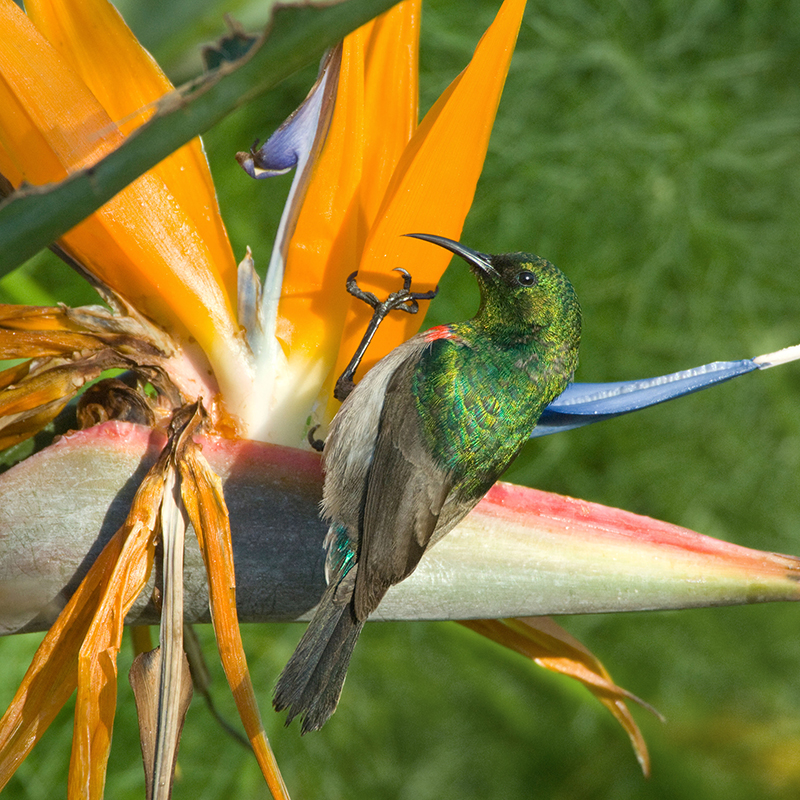
NECTAR NABBER
A southern lesser double-collared sunbird is drawn to bird-of-paradise blooms for the nectar, but its beak shape allows it to reach in from the side, rather than perching on the the blue spathe. (Photo by: Genevieve Vallee/Alamy Stock Photo)
Sunbirds were long thought to be the primary pollinator for Strelitzia, because they were seen on the flowers and have a beak that seems well suited to the task of extracting nectar from bird-of-paradise flowers. However, long hours of observation revealed the sunbirds to be not so much pollinators as nectar thieves. Again and again, these birds were seen with their feet not on the petal “pedal,” but on the spathe itself. Their long, curved bill allows them to reach the nectar without stepping on or brushing against the sticky pollen!
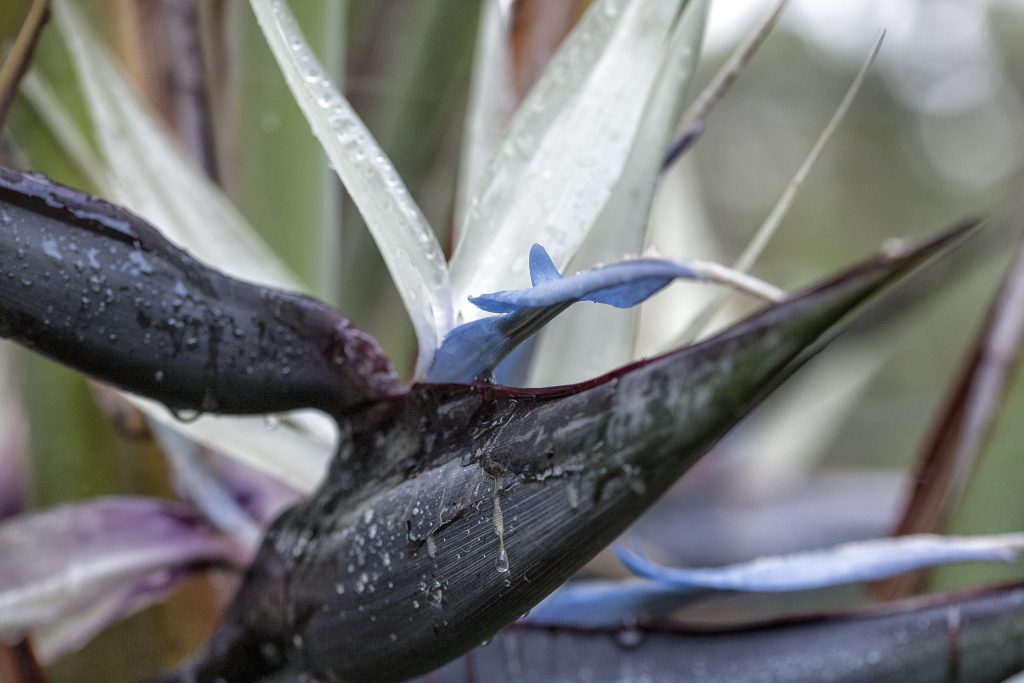
And So It Goes…
Moving from fable to fact, Cape weaver birds Ploceus capensis seem to be one of the primary pollinators of bird-of-paradise (specificially S. reginae) in southern Africa. As Strelitzia have, with human help, become more cosmopolitan, in some instances species in their new homes have filled the pollination niche. When researchers noticed S. reginae plants near them in Southern California producing seeds, they set out to discover the mystery pollinator. An opportunistic feeder, the common yellowthroat Geothylypis trichas had found the secret to opening the nectary, and became a pollinator at the same time.
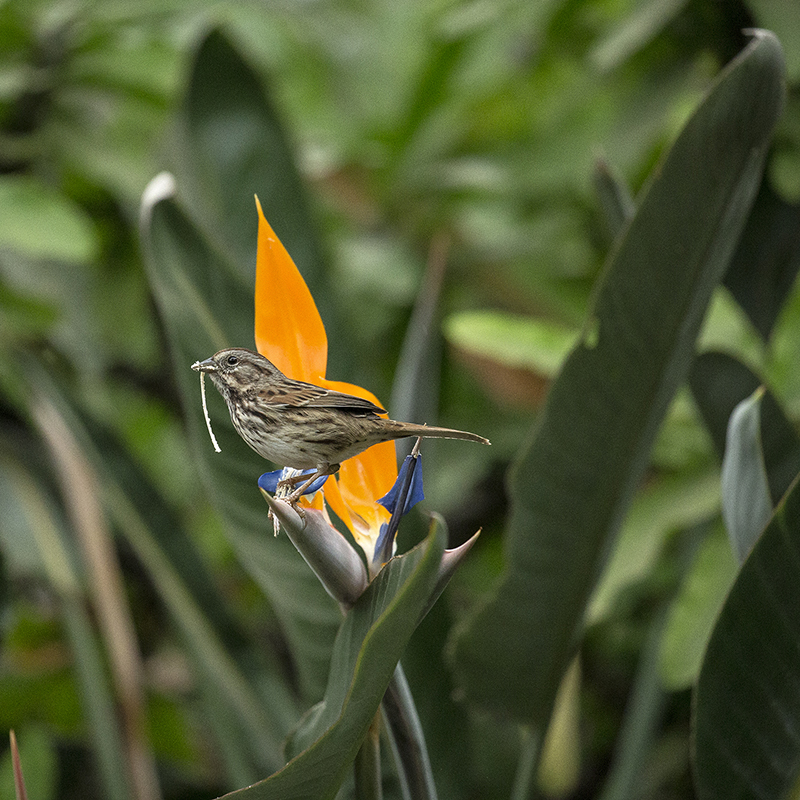
EVERYONE WINS
This song sparrow may be enjoying a beakful of pollen, but check out its feet. The sticky pollen that attaches to its feet will be carried to the next bird-of-paradise plant this hungry bird visits.
After fertilization, the bird-of-paradise flower produces seed pods, which take about two months to mature. Once the pod opens, the plant again relies on vertebrates to move the seeds to a new growing location. Fringed with orange fluff, the seeds attract the attention of a variety of bird species. Some swallow the seeds right there, others carry them away. In either case, the plant’s offspring are spirited off to a spot where they can put down roots—if all goes well. Strelitzia are slow-growing plants; most specimens are propagated by dividing the clumps rather than by germinating seed.
Subtropical by nature, the many species of Strelitzia have been naturalized in North, Central, and South America, as well as in Portugal (where it is the national flower). They prefer temperatures above 50 degrees Fahrenheit, so bird-of-paradise fanciers in cooler climes keep their treasured specimens indoors with access to good light. The tropical touch of the lush greenery and the bold blooms make these plants well worth the pampering needed outside of their warmer comfort zone.

